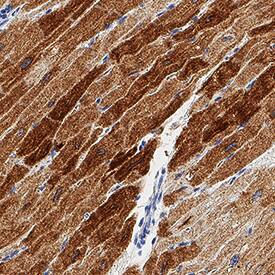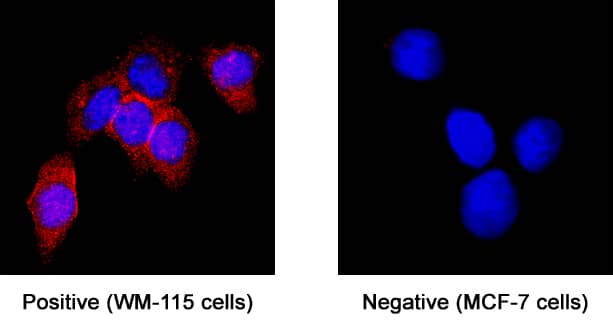Human Lipoprotein Lipase/LPL Antibody
R&D Systems, part of Bio-Techne | Catalog # MAB7197

Key Product Details
Species Reactivity
Human
Applications
Immunocytochemistry, Immunohistochemistry
Label
Unconjugated
Antibody Source
Monoclonal Mouse IgG2B Clone # 1012307
Product Specifications
Immunogen
Chinese Hamster Ovary cell line CHO-derived human Lipoprotein Lipase/LPL protein
Ala28-Gly475
Accession # P06858
Ala28-Gly475
Accession # P06858
Specificity
Detects human Lipoprotein Lipase/LPL in direct ELISAs.
Clonality
Monoclonal
Host
Mouse
Isotype
IgG2B
Scientific Data Images for Human Lipoprotein Lipase/LPL Antibody
Lipoprotein Lipase/LPL in WM-115 Human Cell Line.
Lipoprotein Lipase/LPL was detected in immersion fixed WM-115 human malignant melanoma cell line (positive staining) and MCF-7 human breast cancer cell line (negative control) using Mouse Anti-Human Lipoprotein Lipase/LPL Monoclonal Antibody (Catalog # MAB7197) at 8 µg/mL for 3 hours at room temperature. Cells were stained using the NorthernLights™ 557-conjugated Anti-Mouse IgG Secondary Antibody (red; NL007) and counterstained with DAPI (blue). Specific staining was localized to cytoplasm. Staining was performed using our protocol for Fluorescent ICC Staining of Non-adherent Cells.Lipoprotein Lipase/LPL in Human Heart.
Lipoprotein Lipase/LPL was detected in immersion fixed paraffin-embedded sections of human heart using Mouse Anti-Human Lipoprotein Lipase/LPL Monoclonal Antibody (Catalog # MAB7197) at 5 µg/mL for 1 hour at room temperature followed by incubation with the Anti-Mouse IgG VisUCyte™ HRP Polymer Antibody (VC001)). Before incubation with the primary antibody, tissue was subjected to heat-induced epitope retrieval using Antigen Retrieval Reagent-Basic (CTS013). Tissue was stained using DAB (brown) and counterstained with hematoxylin (blue). Specific staining was localized to cytoplasm in cardiomyocytes. Staining was performed our protocol for IHC Staining with VisUCyte HRP Polymer Detection Reagents.Applications for Human Lipoprotein Lipase/LPL Antibody
Application
Recommended Usage
Immunocytochemistry
8-25 µg/mL
Sample: Immersion fixed WM-115 human malignant melanoma cell line
Sample: Immersion fixed WM-115 human malignant melanoma cell line
Immunohistochemistry
5-25 µg/mL
Sample: Immersion fixed paraffin-embedded sections of human heart
Sample: Immersion fixed paraffin-embedded sections of human heart
Formulation, Preparation, and Storage
Purification
Protein A or G purified from hybridoma culture supernatant
Reconstitution
Reconstitute at 0.5 mg/mL in sterile PBS. For liquid material, refer to CoA for concentration.
Formulation
Lyophilized from a 0.2 μm filtered solution in PBS with Trehalose. *Small pack size (SP) is supplied either lyophilized or as a 0.2 µm filtered solution in PBS.
Shipping
Lyophilized product is shipped at ambient temperature. Liquid small pack size (-SP) is shipped with polar packs. Upon receipt, store immediately at the temperature recommended below.
Stability & Storage
Use a manual defrost freezer and avoid repeated freeze-thaw cycles.
- 12 months from date of receipt, -20 to -70 °C as supplied.
- 1 month, 2 to 8 °C under sterile conditions after reconstitution.
- 6 months, -20 to -70 °C under sterile conditions after reconstitution.
Background: Lipoprotein Lipase/LPL
References
- Wang, H. and R. H. Eckel (2009) Am. J. Physiol. Endocrinol. Metab. 297:E271.
- Olivecrona, T.G. et al. (1985) J. Biol. Chem. 260:6888.
- Dugi, K. A. (1995) J. Biol. Chem. 270:25396.
- Keiper, T. et al. (2001) J. Lipid Res. 42:1180.
- Camps, L. et al. (1991) J. Lipid Res. 32:1877.
- Savonen, R. et al. (2015) J. Lipid Res. 56:588.
- Ping-Ping, H. et al. (2018) Clin Chim Acta 480:126.
- Takahashi, M. et al. (2013) J. Lipid Res. 54:1124.
- Qui, G. et al. (2007) J. Lipid Res. 48:385.
- Gagne, S. E. et al. (1999) Clin. Genet. 55:450.
- Jensen, M. K. et al. (2009) Am. Heart J. 157:384.
- Wang, C. et al. (2011) Thromb. Res. 128:e107.
- Zhang, W. S. et al. (2015) Int. J. Clin. Exp. Med. 8:9575.
- Ren, L. and X. Ren (2016) Neurosci. Lett. 619:73.
- Chan, L. Y. S. et al. (2002) Hum. Mutat. 20:232.
- Van Bockstaele, F. et al. (2007) Clin. Chem. 53:204.
- Kuemmerle, N.B. et al. (2011) Mol. Cancer Ther. 10:427.
- He, D. et al. (2016) J. Bioinform. Comput. Biol. 14:1650028.
- Takasu, S. et al. (2012) Biochem. Res. 2012:398697.
Alternate Names
LIPD, LPL
Gene Symbol
LPL
UniProt
Additional Lipoprotein Lipase/LPL Products
Product Documents for Human Lipoprotein Lipase/LPL Antibody
Product Specific Notices for Human Lipoprotein Lipase/LPL Antibody
For research use only
